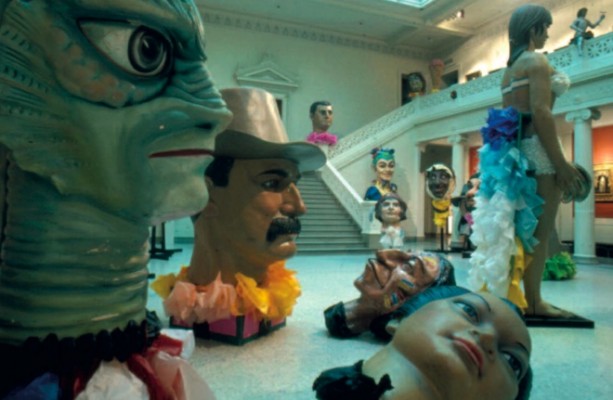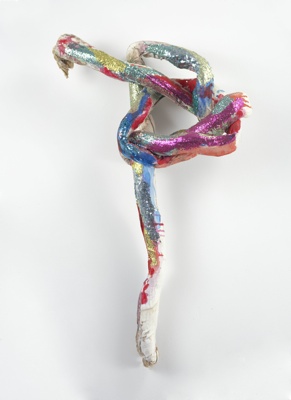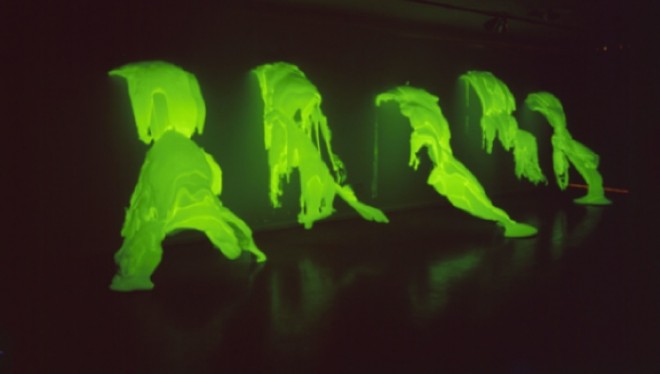Lynda Benglis: Louisiana Avant-Garde, Louisiana Kitsch

Lynda Benglis and Ida Kohlmeyer, Louisiana Prop Piece, 1977. Installation at the New Orleans Museum of Art.
In his late writings, Clement Greenberg doesn’t interact a whole lot with art after Abstract Expressionism. As a critic, Greenberg wasn’t one for irony, and aside from his strong anti-Minimalist stance, Greenberg apparently felt that he had said his piece when the directions suggested by Johns, Rauschenberg, and Pop took hold. He would significantly rework several earlier essays in the 1960s and beyond, but never backed down from his notorious rigidity: a principled avant-garde held aloft one end of the seesaw, ignoble kitsch slumped heavily on the other.
It’s fun to consider how Greenberg might have privately spoken about certain artists in the late ’60s and ’70s, when the medium specificity he heralded as the essence of modernism dissolved and his essentialism became the model for the avant-garde to push back upon. I’ll bet he reserved special venom for Louisiana’s own Lynda Benglis, whose retrospective opened at the New Museum in New York earlier this month. Benglis’ willingness to play the contrarian, to make aggressively unfashionable art that challenged how pejorative classifications like “decorative” are even decreed probably earned her a detractor in the steadfastly earnest Greenberg. But like Greenberg, Benglis also expended major creative energy negotiating abstraction and Jackson Pollock. In the catalogue accompanying the New Museum exhibition, she discusses the genesis of her initial pours of viscous latex in 1967: “It was in the air … what can be done after Pollock, Morris Louis.” In 1956, Life published its famous article on Pollock, “Jack the Dripper.” Sixteen years later, the magazine featured Benglis and her latex “fallen paintings.” Its headline, “Fling, Dribble and Dip,” seems lifted straight from the outtake bin of the Pollock piece.

Lynda Benglis, Sparkle Knot V, 1972. Acrylic paint and sparkles on aluminum screen, cotton bunting, and plaster. Courtesy the artist and Cheim & Read, New York.
Benglis, like Pollock, invented a type of structureless painting; she made hers by spilling latex onto the floor, gushing it, consciously referencing the “toxic oil slicks on the Bayou.” The bizarrely prescient oil spill connotation of the pours is clear enough. Benglis grew up in Lake Charles, home of massive petrochemical refineries and now recognized variously as “cancer alley” and “chemical corridor.” This sense of impurity—her flirtation with toxicity and taboo—is sprinkled through her oeuvre, without even accounting for her massively controversial ad for Artforum in 1974. During the reign of monochromatic American Minimalism, Benglis chose gaudy, radioactive-looking colors for her pours and pigmented polyurethane foam sculptures. Minimalism’s keystone was cold, industrial hardness; Benglis’ kidney-like forms of the late ’60s and early ’70s have all the qualities of doughy human flesh. Minimalism stood there and shut up; Benglis’ puddly lumps slouched in corners or hunkered on the floor, barely concealing their embarrassing secrets.
Benglis’ entire career has been one of pursuing “what’s in the air,” particularly against the general current. You could call this an interest in kitsch, though it’s more specifically an interest in what is stigmatized in art, as well as the art of stigma. Often, especially in the ’70s, this materialized in her work with Louisiana-specific visual flair, as if Benglis was demonstrating the fact of Louisiana as American anomaly, well outside the conformist realm of national suburban visual taste. The “toxic oil slick metaphor” she associated with the fallen paintings hinted at this as early as 1967. Then in 1971 Benglis made a series of imposing installations where massive winglike forms of pigmented polyurethane foam emerge from the wall. The only surviving example of these is the spectacular Phantom, which originally appeared at Kansas State University and is currently re-installed at the New Museum. Some of these 1971 installations were in staid black or white, some in lurid color, but the Phantom forms were covered in phosphorescent salt. Shown in a dark room, they not only glow a ghoulish green, they also perform illusionistically, seeming to shift and melt. In giving Phantom the phosphorescent treatment—one based on lakeside funhouses Benglis attended as a child—she was imbuing the piece with a bit of local lowbrow.

Lynda Benglis, Phantom, 1971. Polyurethane foam with phosphorescent pigments. Courtesy the artist and Cheim & Read, New York.
Throughout the ’70s, Benglis would return to aesthetics that were familiar in Louisiana but mostly thought out of place in the dominant art world: ornamentation and decoration, abstraction, and the sexuality of masquerade. She bedecked her series of Totems and Hoofers—both long, tall, abstract forms mounted on walls—with sparkles and glitter, basically Mardi Gras glitz. But Benglis seemed to react against the straightness of these works, and she began tying them into the tangles that became the gorgeous and mysterious Knots series, soon to morph into the Sparkle Knots, whose flabby, garish skin literalized the lavish and mesmerizing plumage worn by contorting carnival dancers. Benglis’ later series of Lagniappes is her at her most aggressively decorative, as if she made them in defiance of the codes distinguishing “high” from folk art. Literally meaning “something extra,” —essentially swag—the Lagniappes are small, bright, strange constructions of poor materials like plaster and gesso—and, naturally, glitter and sparkles. These individual, handmade sculptures seemed like they had dropped from a fairground vending machine.
In early 1977, New Orleans Museum of Art curator Bill Fagaly arranged an exhibition of five Louisiana artists in commemoration of the American Revolution Bicentennial. "Five From Louisiana" grouped Tina Girouard, Richard Landry, Robert Rauschenberg, Keith Sonnier, and Benglis, who showed several Knots, sculptures from a few other assorted series, and the video How’s Tricks. But Benglis also made a site-specific contribution to the show, a collaboration with her former teacher at Tulane, Ida Kohlmeyer. The pair raided famed Mardi Gras floatmaker Blaine Kern’s studio for unused floats and carnival props, transported them to the museum, and filled the stately Great Hall with the enormous figures, making a bathetic bacchanal of the otherwise imperious setting. Its title: Louisiana Prop Piece. For years, obviously swayed by the Warholian gesture of displacing popular culture into the art world, I misread that title as Louisiana Pop Piece. Maybe I wanted to think of Benglis as extrapolating a Pop position because it provided some context for work that otherwise was so defiant of it. Benglis’ work from the ’70s isn’t reclaiming or “made in celebration of” the decorative and vernacular, it’s interrogating why such reductive and unproductive lines are drawn in the sand at all—whom they service and whom they repress. So no wonder Clem clammed up.
Editor's Note
“Lynda Benglis” on view through June 19, 2011 at the New Museum in New York.



